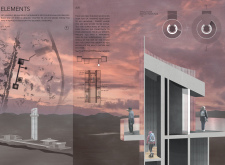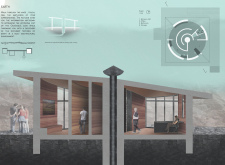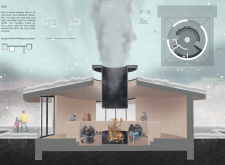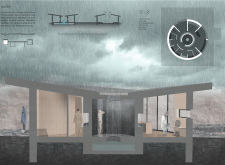5 key facts about this project
At its core, the project represents a tribute to the dynamic elements that shape Iceland's environment. By integrating these four elemental forces into its architecture, the design serves multiple functions, including communal gathering, individual reflection, and immersive nature experiences. The intended outcome is to foster a deeper connection between people and their surroundings, providing spaces that invite exploration and engagement with the elemental forces.
The delineation of the space into four distinct pavilions—Air, Earth, Fire, and Water—demonstrates an innovative approach to design. The Air pavilion features vertical spaces that utilize metallic pipes, symbolizing the lightness and fluidity of air. These pipes create both visual and auditory components, offering visitors an interactive experience as they navigate upward through the structure. This not only enhances the sensory nature of the architecture but also provides panoramic views that connect the interior to the vast Icelandic landscapes.
Similarly, the Earth pavilion is characterized by a maze-like layout that emphasizes solidity and texture. Through the use of natural stone and wood, this section of the project evokes a tactile connection to the geological narrative of the region. Visitors are encouraged to engage with these materials, facilitating a physical relationship with the earth that highlights its historical significance. The design of this space invites exploration, creating a journey that celebrates the characteristics of the landscape.
In contrast, the Fire pavilion centers around a communal gathering space that features a heart-warming fire pit. This area employs warm tones and comfortable seating, creating an inviting atmosphere that fosters social interaction. The fire element serves not only as a source of warmth but also as a catalyst for connection, drawing people together in a setting that encourages conversation and reflection.
The Water pavilion emphasizes the fluidity of movement and experience, presenting wet areas designed for relaxation and rejuvenation. The materials used in this pavilion—such as stone, wood, and glass—contribute to a calming environment that echoes the natural elements of water. Visitors engage with their senses as they prepare for bathing experiences, connecting them to Iceland's geothermal heritage and the health benefits associated with natural waters.
Unique design approaches characterized by sustainability and ecological awareness are integral to the project. By harnessing geothermal energy for heating and cooling purposes, the design reflects a commitment to environmental responsibility that aligns with Iceland's ecological ethos. The thoughtful integration of these sustainable practices into the architecture enhances the overall narrative of harmony between the built environment and the natural world.
Throughout the project, the interplay of various materials enhances the sensory experience and promotes engagement with the elemental themes. The design intentionally creates spaces that are not only functional but also rich in meaning, fostering a deep appreciation for the surrounding landscape.
For those interested in further exploring this architectural project, a closer look at the architectural plans, architectural sections, and architectural designs will provide deeper insights into the intricacies of the project. Take the time to discover the architectural ideas that bring this concept to life, understanding how it represents both innovation and a respect for the natural elements that define its context.


























